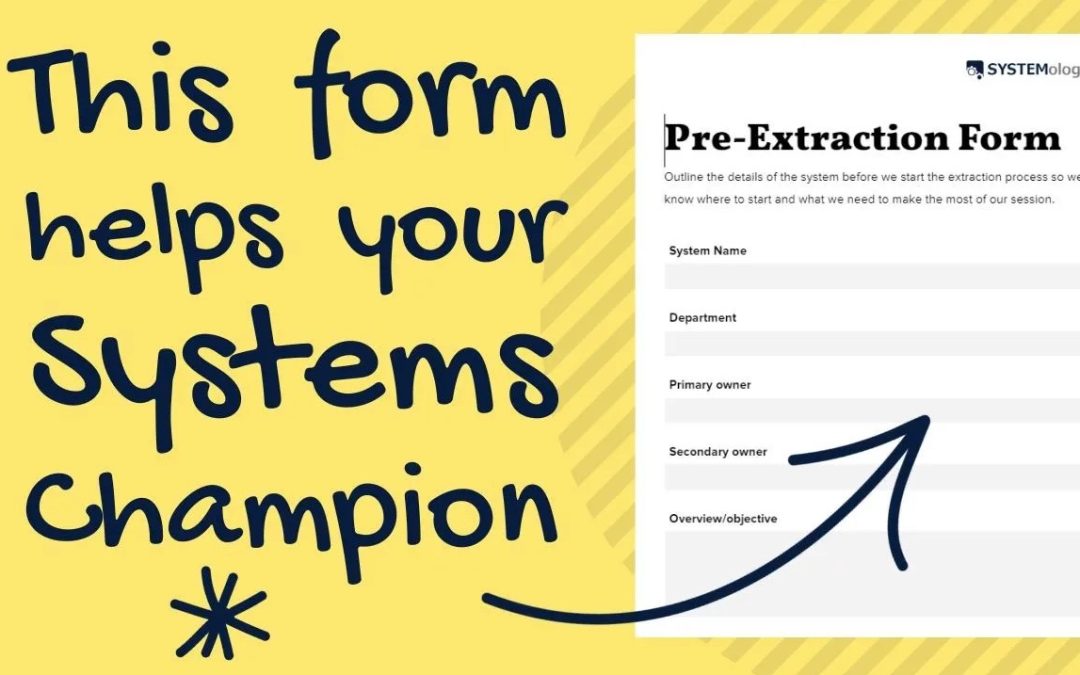Have you ever tried to record a process with a team member and it all went horribly wrong? Or does your documentation process feel like a treasure hunt with no map? The good news is, there is a better way.
Introducing our pre-extraction form – a simple solution that will make creating systems a breeze.
Imagine less time spent on backtracking and more time spent on moving forward.
Our pre-extraction form will help you identify
- Why you need the system,
- The trigger for the system, and
- The critical steps that need to be taken.
It’s time to streamline your team’s work process and make it more efficient.
Grab your copy of the pre-extraction form here.
Timestamps:
0:03 – The Pre-extraction form.
1:38 – Why: Context for the system.
1:55 – Trigger: What kick starts this system?
2:12 – Critical Steps
2:32 – Ending: How do you know when you’re done?
2:48 – What does success look like?
Formatted Transcription:
Having a form or something that you can send to a team member before they do their extraction with you makes it so much easier for them to think through. It’s a simple form that takes five or ten minutes, helps them to identify the key main points, and share with you so you know what the key steps are. They know the key steps they want to cover and once you understand it, it’s easier for you to guide and direct as well.
You’ll get really good at asking questions and knowing when you need more detail. When is, “hey, let’s keep this moving, maybe we don’t need that point.” You’ve gone down this little side rabbit hole of a very odd exception that’s going to happen very rarely and we probably don’t need to systemize for that. So, you’ll get good at reading and understanding that.
Part of this is this pre-extraction form where you can do some of that thinking. There’s going to be a lot of people you meet that won’t fill out the pre-extraction form before you meet them either because they’re knowledgeable workers, or they’re busy. So sometimes, as a system champion, you might go, “well let’s fill that form out first.” And you’ll do that right at the start. Just so you’ve got the full context as you’re getting started.
The better you get at this, you won’t need to use it as much because there might be parts of the business that you already know pretty well, but you can already start to get a feeling for how you’re going to get to know the business so well. You move around as a systems champion through all of the different departments, the training covers this idea of the essential elements of a system. The more I’ve done this, these really are the key things. If you get this right, you go a really long way to making sure that the system is useful.
First, you want to cover why. That’s about setting the context and one of the areas we talked about in the overcoming resistance triangle, you want to set a little bit of a context of where the system fits into the bigger picture and why it is important. That goes into the system overview at the top.
Next, you want to identify the trigger. What kickstarts this system? Is it something that happens on a recurring basis and you get a calendar reminder? Is it something that is triggered by a client making a purchase or an inquiry coming in? What is the trigger for you to know that this system needs to be executed?
The next critical component here is the critical steps. Obviously then identifying what are the critical steps that you’re going to go through. We talk about having those as little almost like mini headlines. You should be able to read each line of those critical steps without going into all of the detail and still have a flow or an understanding of what steps need to get complete for this to happen.
Then you finish up with the ending. How do you know when you’re done and what happens next? Like, is this something that then needs to be notified to a supervisor or marked off in your project management?









